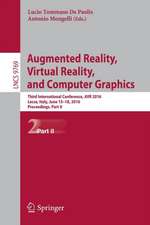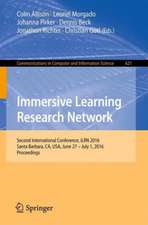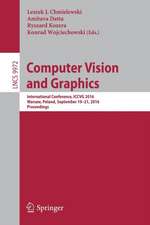Knowledge-Based Vision-Guided Robots: Studies in Fuzziness and Soft Computing, cartea 103
Autor Nick Barnes, Zhi-Quiang Liuen Limba Engleză Paperback – 2 aug 2012
Din seria Studies in Fuzziness and Soft Computing
- 20%
 Preț: 999.85 lei
Preț: 999.85 lei - 20%
 Preț: 653.06 lei
Preț: 653.06 lei - 20%
 Preț: 872.98 lei
Preț: 872.98 lei - 20%
 Preț: 930.57 lei
Preț: 930.57 lei - 20%
 Preț: 1051.00 lei
Preț: 1051.00 lei - 20%
 Preț: 992.44 lei
Preț: 992.44 lei - 20%
 Preț: 655.85 lei
Preț: 655.85 lei - 20%
 Preț: 1001.86 lei
Preț: 1001.86 lei - 18%
 Preț: 954.14 lei
Preț: 954.14 lei - 20%
 Preț: 333.04 lei
Preț: 333.04 lei - 20%
 Preț: 997.56 lei
Preț: 997.56 lei -
 Preț: 391.61 lei
Preț: 391.61 lei - 20%
 Preț: 647.79 lei
Preț: 647.79 lei - 20%
 Preț: 986.01 lei
Preț: 986.01 lei - 18%
 Preț: 958.56 lei
Preț: 958.56 lei - 20%
 Preț: 996.40 lei
Preț: 996.40 lei - 20%
 Preț: 999.35 lei
Preț: 999.35 lei - 15%
 Preț: 646.43 lei
Preț: 646.43 lei - 20%
 Preț: 651.57 lei
Preț: 651.57 lei - 20%
 Preț: 997.89 lei
Preț: 997.89 lei - 15%
 Preț: 641.03 lei
Preț: 641.03 lei - 20%
 Preț: 1009.74 lei
Preț: 1009.74 lei - 20%
 Preț: 992.62 lei
Preț: 992.62 lei -
 Preț: 388.72 lei
Preț: 388.72 lei - 18%
 Preț: 1223.43 lei
Preț: 1223.43 lei - 20%
 Preț: 651.42 lei
Preț: 651.42 lei - 18%
 Preț: 951.59 lei
Preț: 951.59 lei - 18%
 Preț: 948.61 lei
Preț: 948.61 lei
Preț: 330.10 lei
Preț vechi: 412.62 lei
-20% Nou
Puncte Express: 495
Preț estimativ în valută:
63.18€ • 68.66$ • 53.11£
63.18€ • 68.66$ • 53.11£
Carte tipărită la comandă
Livrare economică 21 aprilie-05 mai
Preluare comenzi: 021 569.72.76
Specificații
ISBN-13: 9783662003121
ISBN-10: 3662003120
Pagini: 248
Ilustrații: X, 212 p. 174 illus.
Dimensiuni: 155 x 235 x 13 mm
Greutate: 0.35 kg
Ediția:Softcover reprint of the original 1st ed. 2002
Editura: Physica-Verlag HD
Colecția Physica
Seria Studies in Fuzziness and Soft Computing
Locul publicării:Heidelberg, Germany
ISBN-10: 3662003120
Pagini: 248
Ilustrații: X, 212 p. 174 illus.
Dimensiuni: 155 x 235 x 13 mm
Greutate: 0.35 kg
Ediția:Softcover reprint of the original 1st ed. 2002
Editura: Physica-Verlag HD
Colecția Physica
Seria Studies in Fuzziness and Soft Computing
Locul publicării:Heidelberg, Germany
Public țintă
Professional/practitionerCuprins
1 Introduction.- 1.1 Background.- 1.2 Aims of the Research Presented in this Book: A Problem in Robot Vision.- 1.3 The Approach of this Book.- 1.4 About the Chapters.- 2 Related Systems and Ideas.- 2.1 Basic computer vision approaches.- 2.2 Vision-Guided Mobile Robot Systems.- 2.3 Computer Vision for Mobile Robots.- 2.4 Conclusion.- 3 Embodied Vision For Mobile Robots.- 3.1 Introduction.- 3.2 The Classical Computer Vision Paradigm.- 3.3 Problems with Classical Computer Vision.- 3.4 Applying Embodied Concepts in Human Vision.- 3.5 Embodiment of Vision-guided Robots.- 3.6 Embodiment for Vision-guided Robots.- 3.7 Conclusion.- 4 Object Recognition Mobile Robot Guidance.- 4.1 Introduction.- 4.2 System Perspective.- 4.3 Object Recognition.- 4.4 Determining Object Pose and Distance.- 4.5 Conclusion.- 5 Edge Segmentation and Matching.- 5.1 Edge Extraction.- 5.2 Edge Matching.- 6 Knowledge Based Shape from Shading.- 6.1 Introduction.- 6.2 Using Object Model Knowledge for Shape-From-Shading.- 6.3 A New Boundary Condition for Shape-From-Shading.- 6.4 Knowledge-based Implementation.- 6.5 Experimental Method and Results.- 6.6 Conclusion.- 7 Supporting Navigation Components.- 7.1 Model-based Path Planning.- 7.2 Odometry and Obstacle Avoidance Subsystem.- 8 Fuzzy Control for Active Perceptual Docking.- 8.1 Introduction.- 8.2 Direction Control for Robot Docking.- 8.3 A Fuzzy Control Scheme.- 8.4 Results.- 8.5 Conclusion.- 9 System Results and Case Studies.- 9.1 Evaluation of Components.- 9.2 Case Studies.- 9.3 Conclusion.- 10 Conclusion.- 10.1 Limitations of the Research Presented and Future Work.- 10.2 Extended quotation from Descartes.
Caracteristici
Includes supplementary material: sn.pub/extras















